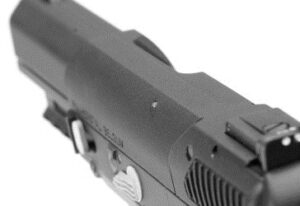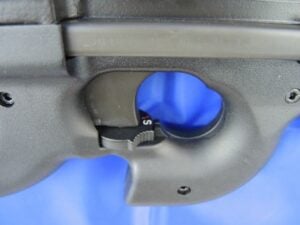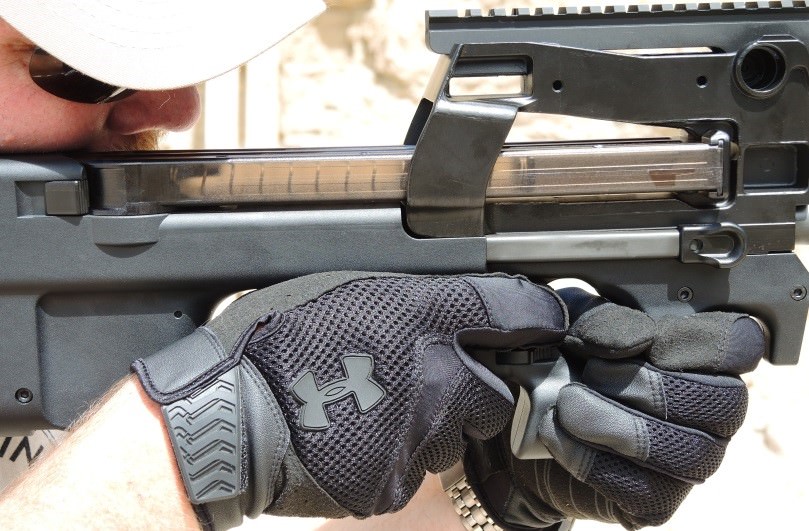
Okay, I’ll admit, the first time I ever saw a Five-Seven pistol being handled or shot was on the History Channel’s Top Shot. I was staggered. Here these guys are blasting away with a gun that shoots a bullet roughly the size of a 22LR at roughly 70 feet hitting a gallon size glass jug while rappelling down a 30 foot tower. For those interested, it was season 4, episode 10.
At that point, I had decided that I needed a closer look at a gun that had that kind of out-of-the-box accuracy. I headed down to my local gun shop that carried FNH products and had a look. Both the Five-Seven and the PS-90 are fairly expensive, and dare I say, exotic, guns. The pistol has a retail price of $1,249 and the carbine will run you about $1,500.
The Cartridge
At this point, I think it’s probably best to discuss the cartridge these guns fire, and what makes it both unique and uniquely suited for both civilian and law enforcement use.
In about 1990 NATO decided it needed to look for an alternative to the 9MM round. Since body armor had become the norm, it was decided that they needed a way to penetrate body armor. There are certainly ways to get a 9MM round through armor, but they aren’t very efficient in means of deployment and use.

FN answered the call with a round they began developing a few years earlier. Essentially, their round was a smaller diameter bullet sent downrange at high velocity – and quite pointy. The SS190 round was developed as a penetrating round sent downrange by the PS-9/PS-90 at 2,346 fps and through the five-seven at roughly 2,100 fps. All the while, the 5.7X28 round weighs about a half of what a 9MM 115 grain bullet does, and recoil is cut down by about 30%.
Essentially, FN had developed a round that could penetrate armor and the average person could carry more of due to its much lighter weight, load more in the same space as any other conventional weapon all with less muzzle rise, keeping it much more accurate. That’s quite an achievement.
The civilian version of the cartridge that you and I can go buy is not armor penetrating as classified by the BATF. There are two different rounds available from FNH and one available from American Eagle. The FNH rounds are designated SS195LF 27 grain lead-free hollow points and the SS197SR 40 grain Hornady V-Max bullet “sporting cartridge”. American Eagle’s offering is the 40 grain AE5728A.
There are a number of places to get the ammo, now. Several months ago it was nearly non-existent anywhere. Cabela’s has been pretty good about keeping both the American Eagle and the FNH SS197SR in stock. There is about a $2 per fifty round box difference in price between the American Eagle and the SS197SR stuff. Either way, you’re paying roughly $27 – $30 per box. That makes shooting these guns a fairly expensive affair. However, if you want something unique and exotic, and you have your mortgage paid off, these guns just might be for you.
FIVE-SEVEN (Pistol)

Let’s just say it, this is a large handgun. It’s a full size frame, polymer with a polymer covered slide. The magazine is polymer, the controls are plastic, this is a very lightweight contender for its size. FNH claims its empty weight to be 1.46 pounds. Our scale showed it to be exactly 1.46 pounds with the magazine inserted. The barrel is hard chrome and 4.8 inches long. Overall length is 8.2 inches with a total height of 5.75 inches. The width is not advertised by FN, but my calipers said it is 1.09 inches wide at the widest area of the slide and 1.22 inches wide at the grip. The muzzle area is a very narrow 0.95 inches wide.
From the factory, it comes with a nice plastic carry case, two magazines (the capacity varies depending on the state laws in your area), a lock, manual, and a magazine release spring tool. It also comes with an adjustable three dot sight system.
The controls take some getting used to. The slide release and take-down lever/switch are both on the left side of the gun. The manual safety is ambidextrous and located just above the trigger well. It sits right where my trigger finger rests when not snapping off rounds. My thumb on my support hand also rests there naturally. So, not only is it in a bit of a weird place (when compared to other guns), but you have to decide what hand/digit you’re going to use to switch it on and off. I use my trigger finger, it just seems to be easier to manipulate that way. The safety is on when the switch is in the up positions, so switching it off is easily done when moving your trigger puller into the well and sweeping it down on the way there.
The magazine release is a large-ish button on the left side, which can be flipped over and used on the right side. Here is a bit of caution: the early model pistols had a wire spring on the magazine release. They are crap. Mine gave out after about 1,000 rounds or so. I looked into putting it back in. It is nearly impossible. There is a little tool that comes with the gun, but it is still a major pain trying to get it back in place even with the tool. I found myself cursing at the stupid thing as it would spring free every time I got close to driving it down into the slot. Fortunately, FN has figured out that this sucks and they’ve created a new retainer spring. It’s not made of the wire, and a pair of needle-nose pliers will have you up and running in no time. FNH says that all guns manufactured in June of 2010 and later will have the upgraded spring already installed.
The gun is striker-fired, single-action and has the dreaded magazine disconnect (it won’t fire if the mag is dropped). The grip, while a little wide, is manageable, even by smaller hands. It is also aggressively stippled. I find that after shooting it a while, it will leave a lasting impression in your hand. If I’m going to take a second out on the house and fire more than a box of ammo, I’ll usually pull on a pair of gloves. The back-strap is horizontally serrated, also very aggressively. The top of the grip is scalloped to allow a good thumb grip up there. The front of the trigger guard is serrated, providing a good place to put your support hand index finger while firing. The trigger is also vertically serrated. The trigger on this thing is phenomenal. There is virtually no take-up whatsoever. Once you pull it back to the resistance point, it snaps very crisply and about a nice 6 pounds. The reset point is so short as to be almost not there. The trigger is also not overly arched, so it doesn’t fatigue your firing hand.
The slide is beveled very nicely on top near the muzzle. The rear of the slide has excellent serrated polymer grips on either side. Even in the cold with gloves on, it’s easy to get a grip on the slide to rack it. The slide release is within easy reach of your strong hand thumb. On the left side, just aft of the ejection port position, there is a little silver button that acts as a loaded chamber indicator. It provides a visual and tactile indication. When there is no round in the chamber, it remains flush, when loaded, it sticks out of the slide slightly, just enough to run your hand over it in the dark and know you’re locked and loaded. The take-down is a little tricky to learn, but easier once you figure it out. Like most handguns, you move the slide slightly to the rear. Instead of poking out the slide release, on this gun, you move the take-down lever rearwards and, Whammo! The slide comes off, no fuss at all. Installing the slide is even easier. Line up the lug in front of the release switch, drop the slide down and rack it. You’re done.
PS90 (Carbine)

Honestly, the first time I saw this thing, I thought it was a movie prop. It is a bullpup design, with some strange looking hand-holds. Gone are the notorious “pistol grips”. Instead, this weapon was designed with the shooters proper hold in mind. When you pick it up, your hands naturally fall into place, your elbows go to the correct position and your eye sits right behind the reticle. The odd part is that your support hand thumb and your trigger finger share the same hole. While it sounds horrendous, it’s actually very practical. However, this is a weapon I prefer to wear gloves with whenever possible to avoid scratching the base of my thumb with my trigger finger nail.
After you get over the shock of the Starship Troopers look, it’ll grow on you. The design improvements are numerous. There is a top loading magazine, a bottom firing ejector port, ambidextrous charging handle, polymer body, all great stuff. The gun is modular, so the take-down is quite easy. Removing the magazine from the top exposes a large button. Depress it, and the entire barrel assembly slides right out. From there the bolt slides out. That releases the butt plate, take that off and you can remove the entire trigger assembly. Not one tool required, so field stripping is a breeze. It is just as simple to reassemble.


The manual safety resides right below the trigger and is also ambi. It rotates forward and aft, depending on whether you want it on or off. It is clearly marked with an “S” and a red “1”. “1” in this case, means fire. The trigger is a large slab that slides rearward when pulled. It does not swing on a pivot like most other designs. There are no serrations or stippling anywhere on the weapon. Every surface aside from the top rail are completely smooth and in most cases, rounded. The trigger pull came in at a nice 7 pounds.
One of the things I had to get used to was filling the magazine. The cartridges snap into the magazine pointing towards the end of the mag. When you put the next round in, there are some deflectors that case the round going into the mag to rotate perpendicular to where it started. I didn’t have any issues with inserting the rounds, nor with feeding, but like the rest of the gun, it’s just different.

The sights and upper rail remind me of the conning tower on a submarine. The iron sights are tiny. Did you ever make a pinhole camera in elementary school? They are that kind of small. They are at best, what they call, “emergency sights”. Even so, because of the natural position of your face against the weapon, your eye is right in line with it, as I mentioned before. I tried using the iron sights at the range. I’m here to tell you, they are indeed emergency sights. Not that shooting from the hip would be better, but it’d be close. So, if you’re going to spend the money on this carbine, you’d better be prepared to spend a few bucks on a decent optic.

We installed a Trijicon red dot and sighted it in. Once sighted, this thing is a can’t miss weapon. Our friends at Tac*One were having an open range day, so I brought this with me to see how it fared. Joe and I handed it to absolute, never shot a gun before, newbies. They were hitting a 10” steel plate from 25 yards with the very first and every round. We ran it through the hands of at least five different people, men and women, and it never complained, never misfired and never missed.
Conclusions
It appears that with both of these guns FN is trying to build a better mouse trap. Did they pull it off? Absolutely. Even with all the controls in different places, it is very easy to adapt to where they are placed. I know, you own a 1911 and think that the sun rises and sets wherever it is. Well, it’s a 1911 for a reason. I have nothing against them at all, I’m just tired of people thinking that there can be no other design as good as it is. Think about it. The AR platform is a far cry from the M1 Garand, and currently one of the most popular designs aver created. So thinking outside the box is the mother of creation. Both guns have made a serious dent in how we think gun design should be approached. Even the cartridge itself is unique to this platform.
I like both guns. They’re light, agile, and deadly accurate. No tweaking, no fooling around with them, they just work out of the box. The only exception is the terrible iron sights on the carbine, however, that’s easily rectifiable. What I don’t like is the price. They’re expensive and the ammunition is expensive. The least expensive I can find ammo for these runs right at 44 cents per round. If you look around, you can find 9MM for roughly half that price. The price of each of these guns is a little on the high side. Buying the hand gun will set you back $1,250 at Cabelas. The PS90 will run you about $1,300 at one of the online sites (plus shipping and transfer fees). Obviously both will cause your credit card company to call you to report possible fraud at over $3,000. Throw in a few boxes of ammo, and you’re going to have to skip a car payment or two.
Overall, I’m a big fan of both of these platforms. Both make sense for a sporting/target gun. It’s pretty tough to miss with one of these. They make sense from a home defense point of view, as long as you follow the, “know what is beyond your target” rule. I’ve even run into some folks who carry the Five-seven concealed daily. That’s probably not going to happen for me, but I do love target shooting with it.
If you can get your hands on one of these to test or rent, do yourself a favor. Do it. You’ll end up with a jar in your house to save every spare dime you get to go out and buy one of these.









